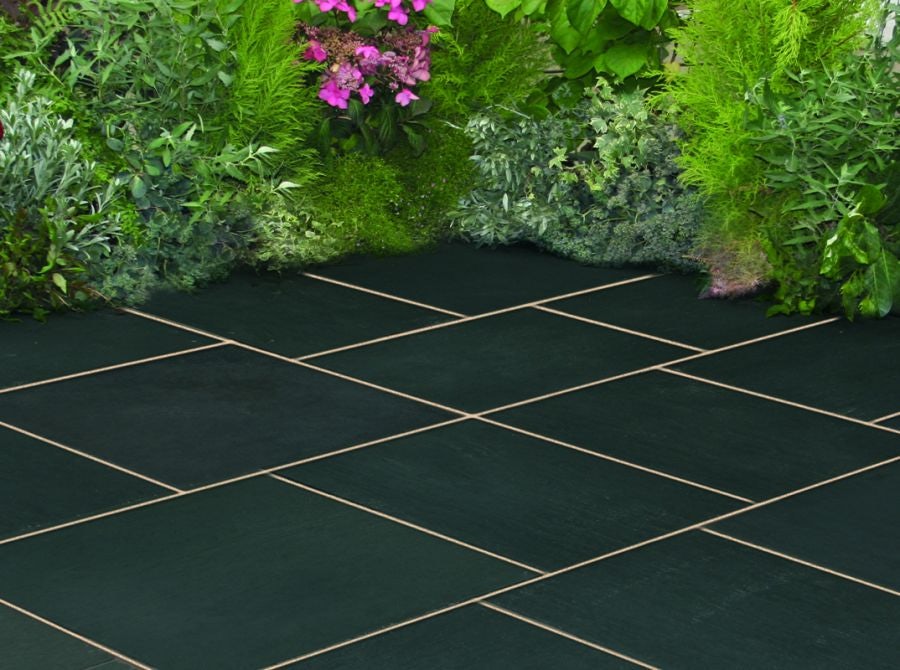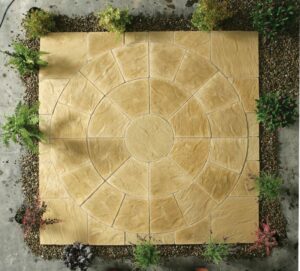Laying a patio can be made simple with the right know-how. Here are some steps to guide you to ensure you can have a suitable space outside of your property.
Table of contents:
How to plan a patio
What you will need
- CAT (Computer Assisted Translation) tool
- String/builder’s line
- Pegs
- Set square
- Spade
Planning the patio
 You will need to make sure you have measurements and markings in place to ensure the patio doesn’t end up being laid incorrectly.
You will need to make sure you have measurements and markings in place to ensure the patio doesn’t end up being laid incorrectly.
Step one: Using a CAT tool, check there are no hidden cables or pipes under the surface you plan to dig into and lay your patio on.
Step two: Mark the position of the patio. This can be done using the string, pegs or a builder’s line. Check the corners are squared using a set square. If they’re not, make sure to adjust them accordingly.
Step three: Using a spade, mark the edge of the patio all the way around, then remove the marking tools you used in step two.
How to prepare a patio base
What you will need
- Spade
- Tamper or wacker plate
Preparing a patio base
Before applying the slabs you will need to make sure the patio base is up to scratch.
Step one: Dig a 150mm depth across the area you plan to pave – this depth should be below the damp proof course of the house. You will also need:
- To allow for 100mm MOT type 1 or hardcore
- 25mm of sand and cement mix
- The thickness of the slab to be installed.
You will also need to make sure the fall is taken into account with your calculations; keep it the same during the process.
Note: If upgrading from older slabs, dig them up before you begin the process.
Step two: Create a slight slope (aka a runoff) to allow rainwater to fall from the patio. 16mm per metre fall is the typical recommendation.
Note: If the patio will be alongside a lawn, make sure it is placed 10mm below ground level – this will support you in future when it comes to long-term mowing.
Step three: Create a 50mm layer using the MOT type 1 or hardcore and a rake. Make this as level as possible then, using a tamper or wacker plate, compress the area to create a base. Then add the other half of the product which should, in total, create a depth of 100mm. Compact this to finalise the base.
How to lay patio slabs
What you will need:
- Patio slabs
- Rubber mallet
- Small strips/offcuts of wood
- Spirit level
- Sand and cement mix
- Tarpaulin
- Trowel
- Brush
Laying patio slabs
Now to begin making the patio!
Step one: Rake out the sand and cement mix approx. a depth of 25mm. Look at the manufacturer’s instructions and use a watering can, either with a fine rose or spray gun, to mix with the material and rake for a level surface.
Step two: Start at the highest point, adding water to the bottom side of the first slab and laying it in the corner. Use a rubber mallet to tap it down into place, ensuring it sits comfortably in place.
From this point, you will be able to use this as a guide in making sure the following slabs are level and square.
Step three: As you lay the slabs, don’t forget to leave space for joint width. You can ensure gaps between slabs are consistent by using an offcut of wood to maintain the desired space.
You will also need to make sure that the slabs are level using your spirit level as you go, ensuring the fall is also suitably level.
Step four: The sand and cement mix will now need to be left to dry for a few days (or at least 24 hours depending on the weather). If these next few days are at risk of rain, place a tarpaulin over the patio to ensure it doesn’t dampen the space. If the space isn’t covered during rain, this can risk the slabs moving out of place.
On the other side, if you’re laying the patio during the summer or extreme heat weather, then make sure it doesn’t dry too fast. This can risk mortar crumbling in place.
 Step five: After the sand and cement mix have dried, you can begin to fill the joints with more sand and cement mix or alternatively dry mortar mix (4 x sand + 1x cement). Make sure it is mixed with enough water for a damp consistency.
Step five: After the sand and cement mix have dried, you can begin to fill the joints with more sand and cement mix or alternatively dry mortar mix (4 x sand + 1x cement). Make sure it is mixed with enough water for a damp consistency.
Apply this mixture to the joints with a trowel and brush any excess away from the surface of the slabs. If you leave the excess, it can dry and stain the surface. So it’s important to rid the space of it as soon as possible.
Note: Check manufacturer instructions if you choose to apply a sealant as some can affect the colour of the slabs.
There you have it! Your very own new patio!

















